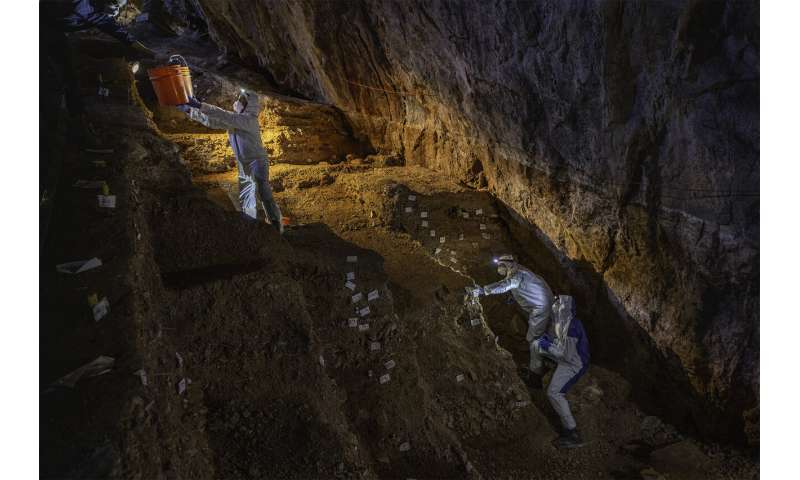
Dr Juan I. Macías-Quintero, Martín Martínez-Riojas, Prof. Eske Willerslev and Dr Mikkel Winther Pedersen (from left to right), collecting samples for ancient DNA analyses at Chiquihuite Cave, 2019. Credit: Devin A. Gandy
Tourists or locals visiting a cave in north-central Mexico could endanger what is purported to be some of the earliest evidence of human presence in North America, archaeological authorities said Thursday.
Mexico's National Institute of Anthropology and History said the remote Chiquihuite cave in Zacatecas state has been declared off-limits to visitors.
Scientists "are looking for the DNA of ancient humans in the sediments (of the cave floor), thus human presence could contaminate strata that has been preserved intact for thousands of years," the institute said.
The cave is located on a hilltop near the town of Concepción del Oro, Zacatecas. Unlike some other famous ice-age caves, there are no clearly visible signs of human habitation like rock paintings, hearths or butchered animal bones at Chiquihuite.
According to an article published earlier this month in the journal Nature, stone tools found in the cave suggest that people were living in North America as early as about 26,500 years ago, about 10,000 years earlier than most scientists accept.
Ciprian Ardelean of the Autonomous University of Zacatecas and others say they found stone tools and debris from tool-making, and said he believed people probably used the cave as a winter shelter for short periods of time. His team has so far been unable to recover any human DNA from the cave.
Explore further Earliest humans stayed at the Americas 'oldest hotel' in Mexican cave
Journal information: Nature
© 2020 The Associated Press. All rights reserved. This material may not be published, broadcast, rewritten or redistributed without permission.
Tourists or locals visiting a cave in north-central Mexico could endanger what is purported to be some of the earliest evidence of human presence in North America, archaeological authorities said Thursday.
Mexico's National Institute of Anthropology and History said the remote Chiquihuite cave in Zacatecas state has been declared off-limits to visitors.
Scientists "are looking for the DNA of ancient humans in the sediments (of the cave floor), thus human presence could contaminate strata that has been preserved intact for thousands of years," the institute said.
The cave is located on a hilltop near the town of Concepción del Oro, Zacatecas. Unlike some other famous ice-age caves, there are no clearly visible signs of human habitation like rock paintings, hearths or butchered animal bones at Chiquihuite.
According to an article published earlier this month in the journal Nature, stone tools found in the cave suggest that people were living in North America as early as about 26,500 years ago, about 10,000 years earlier than most scientists accept.
Ciprian Ardelean of the Autonomous University of Zacatecas and others say they found stone tools and debris from tool-making, and said he believed people probably used the cave as a winter shelter for short periods of time. His team has so far been unable to recover any human DNA from the cave.
Explore further Earliest humans stayed at the Americas 'oldest hotel' in Mexican cave
Journal information: Nature
© 2020 The Associated Press. All rights reserved. This material may not be published, broadcast, rewritten or redistributed without permission.
No comments:
Post a Comment